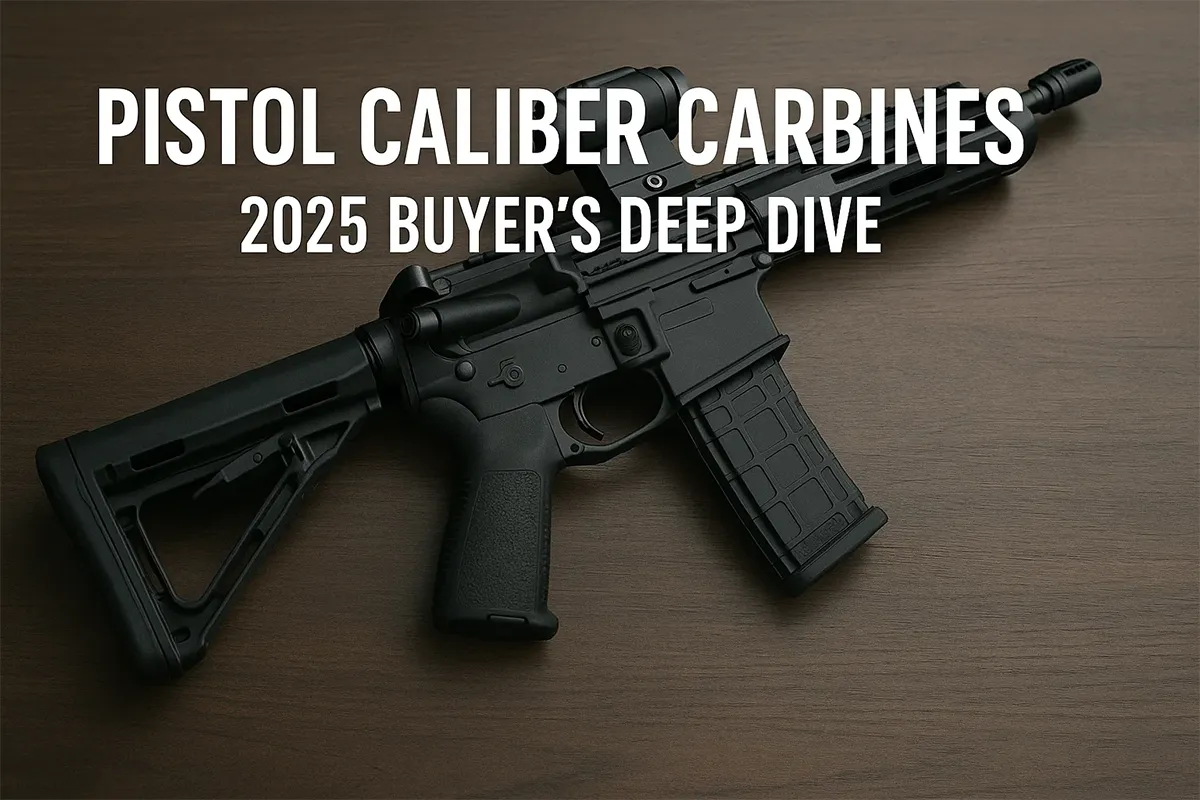Pistol Caliber Carbines: 2025 Buyer’s Deep Dive
November 14, 2025

TL;DR: Pistol caliber carbines (PCCs) keep surging because they’re affordable to feed, easy to shoot, and friendly to indoor ranges. This 2025 deep dive cuts through the buzz and helps you choose a PCC based on recoil feel, magazine ecosystem, and your real use case.
As of November 14, 2025, PCCs are a top crossover pick for new shooters and seasoned competitors alike. They blend the familiarity of handgun ammo with the control of a shoulder-fired platform. In this guide, we explain what’s driving demand, how to sort features that matter (threaded muzzles, optics readiness, mag compatibility), and which brand ecosystems to consider first. We’ll also point you to the right places on GunGenius to compare options by brand and category so you can jump straight from research to window shopping.
The Trend
Three shifts define PCCs in late 2025:
- Mag compatibility is king. Carbines that accept common handgun magazines (notably Glock-pattern) cut costs and simplify logistics. Many shooters already own compatible mags, so a PCC that shares them keeps range days simpler.
- Optics-ready from the factory. Expect full-length top rails, solid receivers, or braced barrel nuts that play nicely with red dots and low-power prism sights. Even budget-focused models now ship optics-ready.
- Suppressor-friendly features. Threaded barrels and tuned gas or blowback systems smooth out shooting with subsonic 9mm loads. While a suppressor adds paperwork and wait time, “ready when you are” hardware is the new default.
From a shopping standpoint, start at the category level to understand the landscape of semi-auto rifles that include PCCs, then drill down by brand for model-specific details:
- Semi-Auto Rifles — the broad home for PCC-style long guns.
- Brands to explore: Ruger, CZ-USA, Smith & Wesson, KelTec.
Spec Highlights & Standouts
When comparing PCCs, focus on these build traits. They translate directly into experience on the range:
- Barrel length (16″ vs. shorter pinned setups). A 16-inch barrel maximizes velocity and keeps things rifle-legal without extra paperwork. Shorter pinned-and-welded barrels keep overall length compact while retaining compliance.
- Operating system (straight blowback vs. delayed systems). Classic blowback is simple and reliable, but can feel “snappy.” Delayed mechanisms (roller, radial, or gas variants) can feel softer and cleaner—handy for high-volume range sessions or competition.
- Controls & ergonomics. AR-style controls reduce the learning curve. Reversible or ambidextrous mag releases and charging handles are a plus for southpaws and competitive reloads.
- Magazine ecosystem. Glock-pattern magazines are ubiquitous and inexpensive. Brand-specific mags can be excellent but check availability and cost in your area.
- Rail & mounting real estate. M-LOK for accessories, continuous top rails for optics, and QD sockets for slings make a carbine more adaptable as your skills evolve.
- Weight & balance. PCCs shine when they’re lively. Sub-7-pound builds generally point quickly and stay nimble with a red dot.
Comparisons
Below is a quick brand-by-brand way to think about your short list. Use it as a map, then jump to brand pages to compare specific models.
- Ruger (brand page): Known for practical, reliable offerings and strong aftermarket support. Ruger PCCs typically hit the sweet spot on price-to-performance and magazine flexibility. If you want a straightforward, optics-ready carbine that “just works,” start here.
- CZ-USA (brand page): Historically associated with refined ergonomics and excellent triggers. CZ’s PCC-style platforms often win on shootability and user feel. Consider these if you prioritize fit, finish, and a premium handling experience.
- Smith & Wesson (brand page): A staple U.S. brand with strong dealer networks and accessory compatibility. Expect modularity, modern controls, and optics-ready trim levels that welcome upgrades over time.
- KelTec (brand page): Innovative designs and compact formats. If portability or a unique folding/packable concept is your priority, KelTec is often the clever outlier—great for range bags and space-limited storage (just don’t try folding time to skip practice).
Searching by category lets you line up multiple PCCs by specs, then pivot into brand pages for model-level nuances like handguard length, trigger type, and factory muzzle devices. That combination—category first, then brand—is the fastest route to a confident pick.
Use Cases & Setup Tips
- Home practice & indoor ranges: 9mm carbines keep costs and blast down. Pair a 1x red dot with a simple two-point sling. If you already own Glock mags, consider a PCC that accepts them to simplify logistics.
- Steel matches & PCC division: Look for delayed systems or well-tuned blowback to soften recoil impulse for fast splits. Oversized charging handles and ambi controls speed up manipulations.
- Training new shooters: PCCs are approachable thanks to low recoil and familiar handgun ammo. A lightweight, adjustable stock and a crisp 1x optic make first-time success more likely.
- Suppressed range sessions: A threaded muzzle is non-negotiable; subsonic 9mm pairs well with pistol-rated cans. Verify the manufacturer’s guidance on backpressure and recoil springs.
What to Watch Next
Expect more factory variants with:
- Better triggers out of the box to satisfy competition and enthusiast shooters.
- Tool-less takedown and modular mag wells to support multiple magazine families.
- Purpose-built optics combos where a carbine ships with a vetted red dot or fixed prism sight.
As you narrow choices, keep both a category view and a brand view open: start with Semi-Auto Rifles to see what’s broadly available, then hop into Ruger, CZ-USA, Smith & Wesson, and KelTec to sanity-check controls, magazine compatibility, and accessory options against your budget.
Ready to price-hunt or check availability? Hit the button below and use “pistol caliber carbine” or a specific model name in the search field to see listings.